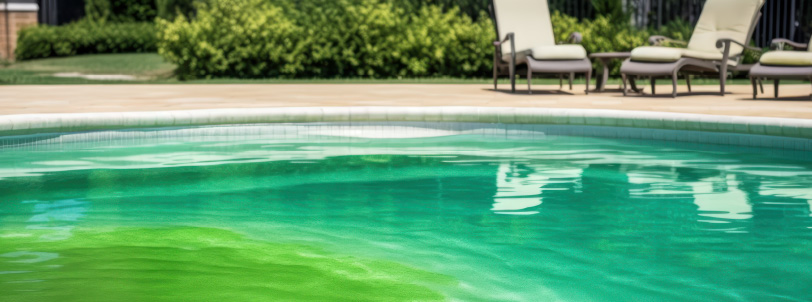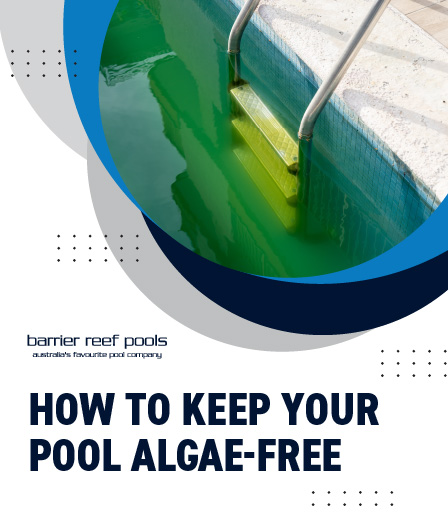How To Keep Your Pool Algae-Free
Owning a pool is a luxury that provides endless enjoyment and relaxation, especially during the hot summer months. However, maintaining a pristine pool can be a challenge, particularly when it comes to preventing algae growth. Algae, the green menace, not only makes your pool look uninviting but can also pose health risks and damage your pool equipment. In this blog post, we'll explore how to keep your pool algae-free, ensuring crystal-clear waters all year round.

Understanding Algae
Types of Algae Found in Pools
Algae are simple, plant-like organisms that thrive in water, often causing issues in swimming pools. They can appear in various forms, each requiring different methods of treatment and prevention:
- Green Algae: The most common type, green algae floats freely in the water or clings to walls and surfaces. It turns the water cloudy and green, making it less appealing for swimming. Green algae can proliferate quickly if not addressed, often due to poor filtration, low chlorine levels, or inadequate pool maintenance.
- Yellow Algae (or Mustard Algae): This type of algae sticks to pool walls and surfaces, resembling pollen or sand. It is more resistant to chlorine than green algae and tends to grow in shaded areas of the pool. Yellow algae can be more difficult to eradicate once it takes hold, often requiring specialised algaecides and thorough brushing of the pool surfaces.
- Black Algae: The most stubborn type, black algae forms dark, persistent spots on pool surfaces and is highly resistant to chlorine. Black algae typically has deep roots that can penetrate porous pool surfaces, making it particularly challenging to eliminate. It often requires aggressive brushing, high chlorine levels, and specific treatments designed to target its root system.
Each type of algae has its own distinct characteristics, but they all share one common trait – they can make your pool unsightly and unsafe. Regular maintenance, proper chemical balancing, and vigilant cleaning are crucial in preventing algae growth and ensuring a clean, inviting swimming pool.
Factors That Contribute to Algae Growth
Understanding what causes algae to flourish is crucial in preventing its growth. Key factors include:
- Water Chemistry: Imbalanced pH levels or low chlorine can create a perfect environment for algae. It’s important to regularly test and adjust the water chemistry to ensure it remains within the recommended ranges. Using algaecides and other treatments can also help keep algae at bay.
- Sunlight: Algae thrive in sunlight, making pools more susceptible during summer. Covering the pool when it’s not in use and maintaining proper chemical levels can help reduce the chances of algae growth due to increased sunlight exposure.
- Lack of Circulation: Stagnant water allows algae to settle and multiply. Ensuring proper circulation through consistent use of the pool pump and filtration system is essential. Regular brushing of the pool walls and floor can also prevent algae from attaching and growing.
By understanding these contributing factors, pool owners can take proactive steps to prevent algae from taking hold. Maintaining a clean and balanced pool environment not only enhances the swimming experience but also extends the longevity of the pool infrastructure. Regular maintenance routines, combined with vigilant monitoring and timely interventions, can significantly reduce the risk of algae infestation.

Preventative Measures
Importance of Maintaining Proper Water Chemistry
Maintaining balanced water chemistry is the first line of defence against algae. Here’s what you need to monitor:
- pH Levels: Keep pH levels between 7.2 and 7.6.
- Chlorine Levels: Maintain free chlorine levels between 1.0 and 3.0 ppm.
- Alkalinity: Ensure total alkalinity is between 80 and 120 ppm.
Regularly testing and adjusting these levels can prevent algae spores from developing into full-blown infestations.
Tips for Regular Cleaning and Maintenance
Consistent upkeep is key to keeping algae at bay. Follow these tips:
- Brush and Vacuum: Regularly brush pool walls and surfaces to dislodge algae spores. Vacuum the pool to remove debris.
- Clean Filters: Ensure filters are cleaned or replaced as needed to maintain proper water circulation.
- Skim Debris: Skim the surface of your pool daily to remove leaves and other organic matter.
These simple yet effective cleaning routines can greatly reduce the risk of algae growth.
Detecting and Treating Algae
Signs of Algae Growth in Your Pool
Early detection is crucial for effective treatment. Look out for these signs:
- Discoloured Water: Green, yellow, or black tinges in your water.
- Cloudiness: Murky water can indicate the presence of algae.
- Slippery Surfaces: Slimy pool walls are often a sign of algae starting to form.
Identifying algae early can make treatment much easier and more effective.
Step-by-Step Guide on How to Treat and Remove Algae
If you find your pool infested with algae, follow these steps to reclaim your sparkling waters:
- Shock the Pool: Use a pool shock treatment to quickly raise chlorine levels and kill algae.
- Brush and Vacuum: Thoroughly brush the pool surfaces and vacuum to remove dead algae.
- Clean the Filters: After treatment, clean or backwash the filters to remove any remaining algae spores.
- Use an Algaecide: Apply a quality algaecide to prevent regrowth.
This methodical approach will help you eliminate algae and restore your pool’s clarity.

Advanced Tips for Algae Prevention
Utilising Algaecides and Other Preventative Products
In addition to regular maintenance, consider these advanced measures:
- Algaecides: Use algaecides regularly to inhibit algae growth. Choose one that is compatible with your pool’s water chemistry.
- Phosphate Removers: Phosphates are nutrients for algae. Removing them can starve algae of what they need to grow.
These products provide an extra layer of protection against algae.
The Role of Pool Covers, Cleaning Equipment, and Regular Maintenance Schedules
Implementing preventive equipment and schedules can further safeguard your pool:
- Pool Covers: Use covers when the pool is not in use to reduce sunlight exposure and debris accumulation.
- Automatic Cleaners: Invest in a robotic pool cleaner for hands-free maintenance.
- Maintenance Schedule: Create a regular cleaning and chemical testing schedule to ensure consistent upkeep.
These strategies will help maintain a pristine and algae-free pool environment.
Conclusion
Keeping your pool free of algae is essential for ensuring a clean and enjoyable swimming experience. By understanding the types of algae, maintaining proper water chemistry, and following regular cleaning routines, you can significantly reduce the risk of algae growth. Additionally, utilising advanced preventative products and equipment can provide extra protection.
Implement these strategies, and you’ll enjoy crystal-clear waters all season long. For further assistance, consider booking a consultation with a pool maintenance expert who can help tailor a plan to your specific needs.
How To Keep Your Pool Algae-Free
Owning a pool is a luxury that provides endless enjoyment and relaxation, especially during the hot summer months. However, maintaining a pristine pool can be a challenge, particularly when it comes to preventing algae growth. Algae, the green menace, not only makes your pool look uninviting but can also pose health risks and damage your pool equipment. In this blog post, we'll explore how to keep your pool algae-free, ensuring crystal-clear waters all year round.

Understanding Algae
Types of Algae Found in Pools
Algae are simple, plant-like organisms that thrive in water, often causing issues in swimming pools. They can appear in various forms, each requiring different methods of treatment and prevention:
- Green Algae: The most common type, green algae floats freely in the water or clings to walls and surfaces. It turns the water cloudy and green, making it less appealing for swimming. Green algae can proliferate quickly if not addressed, often due to poor filtration, low chlorine levels, or inadequate pool maintenance.
- Yellow Algae (or Mustard Algae): This type of algae sticks to pool walls and surfaces, resembling pollen or sand. It is more resistant to chlorine than green algae and tends to grow in shaded areas of the pool. Yellow algae can be more difficult to eradicate once it takes hold, often requiring specialised algaecides and thorough brushing of the pool surfaces.
- Black Algae: The most stubborn type, black algae forms dark, persistent spots on pool surfaces and is highly resistant to chlorine. Black algae typically has deep roots that can penetrate porous pool surfaces, making it particularly challenging to eliminate. It often requires aggressive brushing, high chlorine levels, and specific treatments designed to target its root system.
Each type of algae has its own distinct characteristics, but they all share one common trait – they can make your pool unsightly and unsafe. Regular maintenance, proper chemical balancing, and vigilant cleaning are crucial in preventing algae growth and ensuring a clean, inviting swimming pool.
Factors That Contribute to Algae Growth
Understanding what causes algae to flourish is crucial in preventing its growth. Key factors include:
- Water Chemistry: Imbalanced pH levels or low chlorine can create a perfect environment for algae. It’s important to regularly test and adjust the water chemistry to ensure it remains within the recommended ranges. Using algaecides and other treatments can also help keep algae at bay.
- Sunlight: Algae thrive in sunlight, making pools more susceptible during summer. Covering the pool when it’s not in use and maintaining proper chemical levels can help reduce the chances of algae growth due to increased sunlight exposure.
- Lack of Circulation: Stagnant water allows algae to settle and multiply. Ensuring proper circulation through consistent use of the pool pump and filtration system is essential. Regular brushing of the pool walls and floor can also prevent algae from attaching and growing.
By understanding these contributing factors, pool owners can take proactive steps to prevent algae from taking hold. Maintaining a clean and balanced pool environment not only enhances the swimming experience but also extends the longevity of the pool infrastructure. Regular maintenance routines, combined with vigilant monitoring and timely interventions, can significantly reduce the risk of algae infestation.

Preventative Measures
Importance of Maintaining Proper Water Chemistry
Maintaining balanced water chemistry is the first line of defence against algae. Here’s what you need to monitor:
- pH Levels: Keep pH levels between 7.2 and 7.6.
- Chlorine Levels: Maintain free chlorine levels between 1.0 and 3.0 ppm.
- Alkalinity: Ensure total alkalinity is between 80 and 120 ppm.
Regularly testing and adjusting these levels can prevent algae spores from developing into full-blown infestations.
Tips for Regular Cleaning and Maintenance
Consistent upkeep is key to keeping algae at bay. Follow these tips:
- Brush and Vacuum: Regularly brush pool walls and surfaces to dislodge algae spores. Vacuum the pool to remove debris.
- Clean Filters: Ensure filters are cleaned or replaced as needed to maintain proper water circulation.
- Skim Debris: Skim the surface of your pool daily to remove leaves and other organic matter.
These simple yet effective cleaning routines can greatly reduce the risk of algae growth.
Detecting and Treating Algae
Signs of Algae Growth in Your Pool
Early detection is crucial for effective treatment. Look out for these signs:
- Discoloured Water: Green, yellow, or black tinges in your water.
- Cloudiness: Murky water can indicate the presence of algae.
- Slippery Surfaces: Slimy pool walls are often a sign of algae starting to form.
Identifying algae early can make treatment much easier and more effective.
Step-by-Step Guide on How to Treat and Remove Algae
If you find your pool infested with algae, follow these steps to reclaim your sparkling waters:
- Shock the Pool: Use a pool shock treatment to quickly raise chlorine levels and kill algae.
- Brush and Vacuum: Thoroughly brush the pool surfaces and vacuum to remove dead algae.
- Clean the Filters: After treatment, clean or backwash the filters to remove any remaining algae spores.
- Use an Algaecide: Apply a quality algaecide to prevent regrowth.
This methodical approach will help you eliminate algae and restore your pool’s clarity.

Advanced Tips for Algae Prevention
Utilising Algaecides and Other Preventative Products
In addition to regular maintenance, consider these advanced measures:
- Algaecides: Use algaecides regularly to inhibit algae growth. Choose one that is compatible with your pool’s water chemistry.
- Phosphate Removers: Phosphates are nutrients for algae. Removing them can starve algae of what they need to grow.
These products provide an extra layer of protection against algae.
The Role of Pool Covers, Cleaning Equipment, and Regular Maintenance Schedules
Implementing preventive equipment and schedules can further safeguard your pool:
- Pool Covers: Use covers when the pool is not in use to reduce sunlight exposure and debris accumulation.
- Automatic Cleaners: Invest in a robotic pool cleaner for hands-free maintenance.
- Maintenance Schedule: Create a regular cleaning and chemical testing schedule to ensure consistent upkeep.
These strategies will help maintain a pristine and algae-free pool environment.
Conclusion
Keeping your pool free of algae is essential for ensuring a clean and enjoyable swimming experience. By understanding the types of algae, maintaining proper water chemistry, and following regular cleaning routines, you can significantly reduce the risk of algae growth. Additionally, utilising advanced preventative products and equipment can provide extra protection.
Implement these strategies, and you’ll enjoy crystal-clear waters all season long. For further assistance, consider booking a consultation with a pool maintenance expert who can help tailor a plan to your specific needs.







